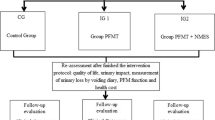Abstract
The aim of this study was to evaluate the effect of intravaginal electrical stimulation (IES) on pelvic floor muscle (PFM) strength in patients with mixed urinary incontinence (MUI). Between January 2001 and February 2002, 40 MUI women (mean age: 48 years) were studied. Urge incontinence was the predominant symptom; 92.5% also presented mild stress urinary incontinence (SUI). Selection criteria were clinical history and urodynamics. Pre-treatment urodynamic study showed no statistical differences between the groups. Ten percent of the women in each group had involuntary detrusor contractions. Patients were randomly distributed, in a double-blind study, into two groups. Group G1 (n=20), effective IES, and group G2 (n=20), sham IES, with follow-up at 1 month. The following parameters were studied: (1) clinical questionnaire, (2) examiner’s evaluation of perineal muscle strength, (3) objective evaluation of perineal muscle by perineometry, (4) vaginal weight test, and (5) urodynamic study. The IES protocol consisted of three 20-min sessions per week over a 7-week period using a Dualpex Uro 996 at 4 Hz. There was no statistically significant difference in the demographic data of both groups. The number of micturitions per 24 h after treatment was reduced significantly in both groups. Urge incontinence, present in all patients before treatment, was reduced to 15% in G1 and 31.5% in G2 post-treatment. The subjective evaluation of PFM strength demonstrated a significant improvement in G1. Objective evaluation of PFM force by perineometer showed a significant improvement in maximum peak contraction post-treatment in both groups. In the vaginal weight test, there was a significant increase in average number of cone retentions post-treatment in both groups. With regard to satisfaction level, after treatment, 80% of the patients in G1 and 65% of the patients in G2 were satisfied. There was no statistically significant difference between the groups. There was a significant improvement in PFM strength from both effective and sham electrostimulation, questioning the effectiveness of electrostimulation as a monotherapy in treating MUI.

Similar content being viewed by others
References
Connolly AM, Thorp JM Jr (1999) Childbirth-related perineal trauma: clinical significance and prevention. Clin Obstet Gynecol 42:820–835
Dimpfl T, Jaeger C, Mueller-Felber W (1998) Myogenic changes of the levator ani muscle in premenopausal women: the impact of vaginal delivery and age. Neurourol Urodyn 17:197–205
Hole DS, Brubaffer L, Heidkamp MC (1999) Histologic analysis of needle biopsy of urethral sphincter from women with normal and stress incontinence with comparison of electromyographic findings. Am J Obstet Gynecol 180:342–348
Perchers UM, Schaer GIN, De Lancey JO (1997) Levator ani function before and after childbirth. Br J Obstet Gynaecol 104:1004–1008
Nygaard I, Kreder K, Lepic M (1996) Efficacy of pelvic floor muscle exercises in women with stress, urge, and mixed incontinence. Am J Obstet Gynecol 174:120–125
Mahony DT, Laferte RO, Blais DJ (1977) Studies of enuresis. VIII. Detrusor and sphincter instability caused by overactivity of integral voiding reflexes. Urology 9:590–601
Flynn L, Cell P, Luisi E (1994) Effectiveness of pelvic muscle exercises in reducing urge incontinence among community residing elders. J Gerontol Nurs 20:23–27
Satore A, Pregazzi R, Bartoli P, Grimaldi E, Ricci G, Gurschino S (2002) The urine stream interruption test and pelvic muscle function in the puerperium. Int J Gynecol Obstet 78:235–239
Bo K, Berghmans LCM (2000) Nonpharmacologic treatments for overactive bladder-pelvic floor exercises. Urology 55:7–11
Brubaker L, Benson JT, Bent A, Clark A (1997) Transvaginal electrical stimulation for female urinary incontinence. Am J Obstet Gynecol 177:536–540
Fall M, Lindstrom S (1998) Functional electrical stimulation: physiological basis and clinical principles. Int Urogynecol J 5:296–304
Messelink EJ (1999) The overactive bladder and the role of pelvic floor muscles. Br J Urol 83:31–35
Amaro JL, Gameiro MOO (2001) Tratamento não cirúrgico: cinesioterapia. In: Rubinstein I (ed) Clínicas urológicas Brasileiras. Incontinência Urinária na Mulher, São Paulo, pp 163–169
Spruijt J, Vierhout M, Verstraeten R, Janssens J, Burger C (2003) Vaginal electrical stimulation of the pelvic floor: a randomized feasibility study in urinary incontinent elderly women. Acta Obstet Gynecol Scand 82:1043–1049
Wang AC, Wang YY, Chen MC (2004) Single-blind, randomized trial of pelvic floor muscle training, biofeedback-assisted pelvic floor muscle training, and electrical stimulation in management of overactive bladder. Urology 63:61–66
Yamanishi T, Kosaku Y, Ryuji S, Hattori T, Suda S (2000) Randomized, double-blind study of electrical stimulation for urinary incontinence due to detrusor overactivity. Urology 55:353–357
Berghmans LCM, Hendriks HJM, De Bier RA, Van Waalwijk Van Doorn ESC, Bo K, Van Kerrebroeck PEV (2000) Conservative treatment of urge urinary incontinence in women: a systematic review of randomized clinical trials. Br J Urol Int 85:254–263
Amaro JL, Gameiro MOO, Padovani CR (2003) Treatment of urinary stress incontinence by intravaginal electrical stimulation and pelvic floor physiotherapy. Int Urogynecol J 14:204–208
Jeyaseelan SM, Oldham JA (2000) Electrical stimulation as a treatment for stress incontinence. Br J Nurs 9:1001–1007
Elbadawi A, Yalla SA, Resnick NM (1993) Structural basis of geriatric voiding dysfunction. III. Detrusor overactivity. J Urol 150:1668–1680
Norman GR, Streiner DL (1994) Biostatistics—the bare essentials. Mosby Year Book, St Louis, p 260
Ohlsson BL, Fall M, Frankenberg-Sommar S (1989) Effects of external and direct pudendal nerve maximal electrical stimulation in the treatment of the uninhibited overactive bladder. Br J Urol 64:374–380
Jeyaseelan SM, Haslam EJ, Winstanley J, Roe BH, Oldham JA (2000) An evaluation of a new pattern of electrical stimulation as a treatment for urinary stress incontinence: a randomized, doubled-blinded, control trial. Clin Rehabil 14:631–640
Author information
Authors and Affiliations
Corresponding author
Rights and permissions
About this article
Cite this article
Amaro, J.L., Gameiro, M.O. & Padovani, C.R. Effect of intravaginal electrical stimulation on pelvic floor muscle strength. Int Urogynecol J 16, 355–358 (2005). https://doi.org/10.1007/s00192-004-1259-0
Received:
Accepted:
Published:
Issue Date:
DOI: https://doi.org/10.1007/s00192-004-1259-0




